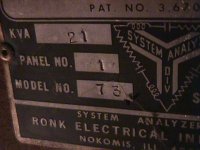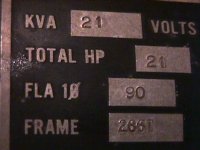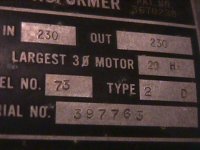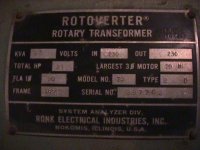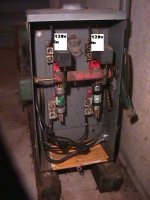gbottolfsen
Plastic
- Joined
- Mar 30, 2008
- Location
- IL.
Hi
I am new to this site, I was referred by someone on MM.com.
I have 220 volt, single phase coming into my house.
I called the power company to see about getting three phase,
they said it was not available.
The power co. told me I could get three phase by using a RPC and
that they had an old one that I could lease at no charge. What a good
deal I thought , until I saw what they brought, OLD, HEAVY 20 HP
, until I saw what they brought, OLD, HEAVY 20 HP
rotary, capacitor start three phase motor on skids. The only reason
for no charge I could see was THIS THING IS GOING TO SUCK UP THE
ELECTRICITY
I had a commercial electriction come in and wire it, and the three
phase output to a circut breaker box in my garage.
Turned it on and started measuring voltage, expecting the voltages
I wanted=READ EVERYTHING ON THIS SITE ABOUT RPC'S.
This is what I read. [B IS THE MANUFACTERED LEG]
A TO B=248V
A TO C=240V
B TO C=294V
A TO NEUTRAL=120V NOTE: NEUTRAL IS THE ALL THE
B TO NEUTRAL=235V WHITE WIRES IN THE CIRCUIT
C TO NEUTRAL=120V BREAKER BOX, BUS.
I do not have a phase meter, or an amp meter. All the readings were
RPC running unloaded, measured at the circuit breaker box LINE IN
bus bars at the top of the box.
My question, are these voltages acceptable to run just plain 220v three phase motors from one to fifteen HP? Only one at time, though


From reading all the posts on this site I am still not sure. ELECTRICITY
AND ME ARE STRANGERS.
Thanks
Gene
I am new to this site, I was referred by someone on MM.com.
I have 220 volt, single phase coming into my house.
I called the power company to see about getting three phase,
they said it was not available.
The power co. told me I could get three phase by using a RPC and
that they had an old one that I could lease at no charge. What a good
deal I thought
 , until I saw what they brought, OLD, HEAVY 20 HP
, until I saw what they brought, OLD, HEAVY 20 HProtary, capacitor start three phase motor on skids. The only reason
for no charge I could see was THIS THING IS GOING TO SUCK UP THE
ELECTRICITY

I had a commercial electriction come in and wire it, and the three
phase output to a circut breaker box in my garage.
Turned it on and started measuring voltage, expecting the voltages
I wanted=READ EVERYTHING ON THIS SITE ABOUT RPC'S.
This is what I read. [B IS THE MANUFACTERED LEG]
A TO B=248V
A TO C=240V
B TO C=294V
A TO NEUTRAL=120V NOTE: NEUTRAL IS THE ALL THE
B TO NEUTRAL=235V WHITE WIRES IN THE CIRCUIT
C TO NEUTRAL=120V BREAKER BOX, BUS.
I do not have a phase meter, or an amp meter. All the readings were
RPC running unloaded, measured at the circuit breaker box LINE IN
bus bars at the top of the box.
My question, are these voltages acceptable to run just plain 220v three phase motors from one to fifteen HP? Only one at time, though



From reading all the posts on this site I am still not sure. ELECTRICITY
AND ME ARE STRANGERS.
Thanks
Gene







